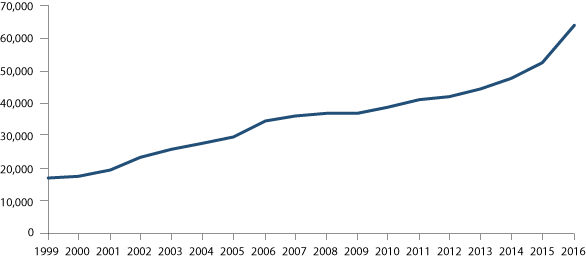Introduction: The opioid crisis
Indiana Business Research Center, Indiana University Kelley School of Business

Since 2003, the number of opioid poisoning deaths in Indiana has increased by more than 500 percent, according to the Indiana State Department of Health. Tens of thousands of Hoosiers are addicted to opioids, be they prescription or illegal. The impact of this crisis, identified as such by public health and government officials alike, can be seen across the state. And that impact is being seen and felt throughout our economy and our workforce.
A new study, published in this issue of the Indiana Business Review, tackles the cumulative costs to the Indiana economy of the ongoing opioid crisis.
Consider the following few graphs from the study—and note the strikingly similar trend lines of inexorable increases year after year.
Figure 1: U.S. drug overdose deaths

Source: PBS NewsHour, using National Center for Health Statistics data
Figure 2: Annual opioid overdose deaths in Indiana

Source: Authors’ calculations
Figure 3: Estimated annual naloxone use events

Source: Authors’ calculations
Figure 4: Estimated hospitalization costs resulting from non-lethal opioid overdose ER visits

Source: Authors’ calculations
In quantifying and understanding the multi-billion dollar economic impact of this very human crisis, the authors, Brewer and Freeman, have estimated the losses in gross state product, lost wages, in hospital and government expenditures stressed beyond their limits, and the costs of those losses across families, businesses and communities. We are publishing their work in the form of three articles in this issue, with the main article (which includes recommendations for future actions) accompanied by analysis of regional and county impact.
Select findings from the statewide analysis
-
Indiana has sustained $43.3 billion in economic damages to date (spanning 2003 to 2017) and an additional $4 billion and more estimated for 2018.
-
More than 12,300 Indiana residents are estimated to have died between 2003 and 2017 due to opioid overdoses. (That's roughly equivalent to the entire population of Pike County.)
-
Indiana potential lost wages due to opioid misuse grew to $752 million in 2016.
-
Non-lethal opioid overdoses cost over $224 million in hospitalization costs in 2016 alone, with an additional $297 million in other opioid-related hospital stays.
-
Upwards of $40 million are spent annually for rehabilitation costs.
-
The cost of drug arrests and court costs exceeds $13 million annually, not to mention the more than $70 million in incarceration costs each year.
-
As of 2016, an estimated 5,243 Hoosier children are in foster care due to parental opioid misuse (more than 600 percent higher than in 2003), while 578 Indiana newborns are estimated to have been born addicted to opioids that year due to maternal drug use (a 140 percent increase since 2003).
The opioid crisis continues to accelerate. Community leaders, officials and state government are banding together to confront this crisis. Now, with this study, the authors have explored the cumulative economic costs in addition to the already too-high costs in the lives and well-being of Hoosiers, their families and their communities.



